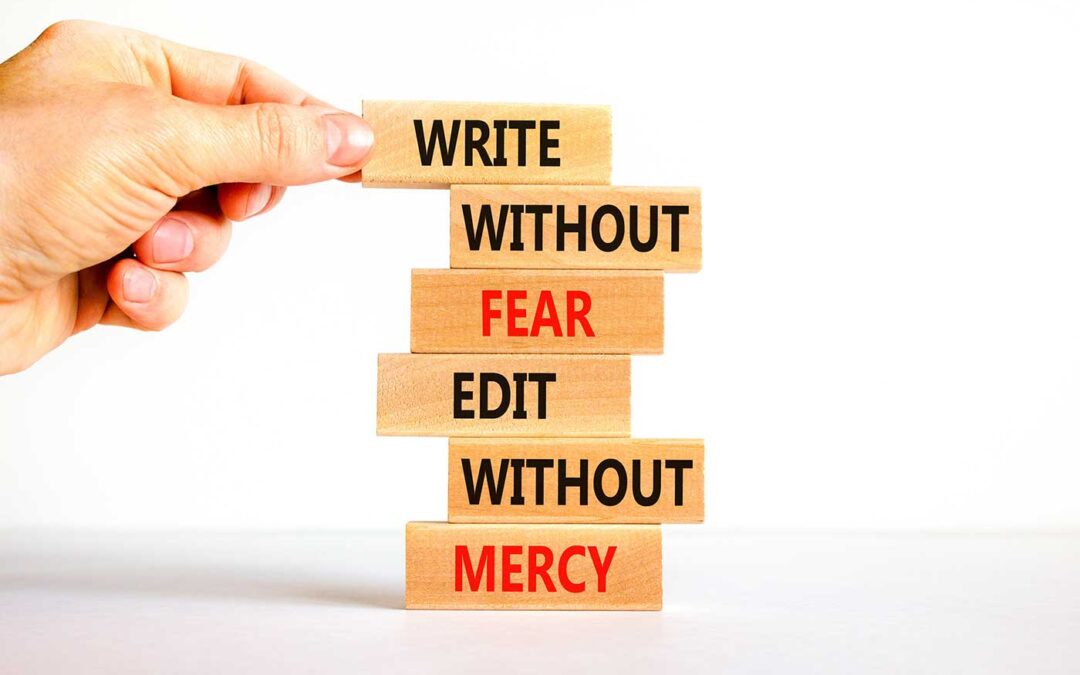As I have advised previously, when writing, the first step is pouring your ideas onto the page and getting them out of your head. You can do that with the confidence that you will edit . . . later.
When “later” comes, it is a good idea to have some strong self-self editing skills. By utilizing such skills you can make sure your work is clear, concise, and engaging. Here are my recommended self-editing strategies that will help you bring out your best writing and increase your quality of work.
1) Set aside your manuscript, and let it be.
As hard as it might be, press SAVE and ignore your writing for a few hours, a few days—even a week. When it’s time for you to get back to it, you’ll have a fresh view, and you’ll be surprised by what you now see.
Fun fact: Stephen King puts his finished drafts in a drawer for a six-week nap before he reviews them.
2) Print it out.
You’ll catch more errors when you take out your writing utensil (red pen or other tool) and mark up your writing. It’s easy to miss errors on the computer screen. Our brains, eyes, and fingers don’t always work together. It’s easier to flip pages back and forth to compare for consistency. And you’ll lessen eyestrain.
Don’t forget to print out your revised manuscript when you do a final proofread.
Bonus tip: Try changing the font, margins, or color of your original before you print. Revert to the original after you’ve made revisions. You’ll see your content differently.
3) Read it out loud.
Initially, you might feel awkward when you do this, but you’ll discover errors in wording, punctuation, or phrases that don’t make sense. You might even find an infamous error such as spelling “public” as “pubic.”
Option: Use a text-to-speech program, or ask someone else to read it back to you.
4) Read for flow first.
Fight against the temptation to get right to the nitty-gritty grammar and spelling. Do you want to give your reader a smooth, enjoyable read, or an experience fraught with jerks, sways, and jolts?
Are your chapters, sections, and sentences in the right order? Do your transitions make sense?
5) Read line by line, looking for grammar and punctuation errors.
These details are the line-by-line OOPS that stop readers in their tracks. OOPS (outrageous, OMG punctuation and spelling slips) can sometimes be funny, but so embarrassing.
Spelling: Spell check is a must, but beware. It only knows how to recognize words in the dictionary. It can’t tell you the difference between homophones such as “to,” “two,” and “too.” You can certainly start with it, but you should look at programs such as Grammarly, ProWriting Aid, Scribens, Hemingway Editor, Ginger, or After the Deadline.
Grammar: No one expects you to remember all the rules, so keep essential resources handy such as:
- The traditional Elements of Style by William Strunk Jr. and E.B. White.
- The tongue-in-cheek but indispensable book and website Quick and Dirty Tips by Grammar Girl, Mignon Fogarty.
- The indispensable, free website The OWL at Purdue (online writing center).
Pay particular attention to:
- Commas, semicolons, apostrophes, quotation marks, dashes, and ellipses.
- Commonly confused words (affect, effect).
- When to use “which” and “that.”
Tip: Every time you find a common error, write it down on a pad, in an Excel document or on a Post-It note. This will make you more aware of your habitual errors. You’ll soon get these slips under control.
6) Slash clichés: words, phrases, and situations.
Clichés make your writing tired and stale. You want to be known for originality, right? Find a unique way to convey tropes like “but at the end of the day” and “think outside the box” and over used phrases like them. Say it in a way you’ve never heard it said before.
7) Get rid of weak adverbs, vague adjectives, and wordy, redundant phrases.
- Weak adverbs such as “very” and “really.” Are you “very tired”? Try “exhausted.” Are you “very hot?” Try “sweltering.”
- Weak, vague adjectives such as “big” and “great.” These non-words don’t say anything. Is the house “big,” or is it “massive”? Is the decision “big” or “significant?” Did the CEO do a “great” job, or was it “stellar”? Use Google Search to find “other words for ——.”
- Wordy or redundant phrases such as:
- – due to the fact that (because)
- – 9 PM in the evening (9 PM)
- – small in size (small)
8) Avoid overusing adverbs.
Some experts think overusing these how, when, where, or why words “tell” rather than “show.” Often, they’re redundant.
- “The student ambled down the hall.” is more descriptive than “The student walked slowly down the hall.”
- “She yelled at him angrily.” How else would she yell?
9) Change passive voice to active voice.
An “active voice” occurs in a sentence where the subject of the sentence performs the action represented by the verb. A “passive voice” occurs when the subject is acted upon by the action represented by the verb. Active voice is preferable because it depicts a more live experience for the reader.
Passive voice sounds historical. For example, “The boy was bit by the dog.” (passive) is clunky and something that happened previously. The more direct version is, “The dog bit the boy,” giving the reader the lived, as it is happening, account. While passive voice isn’t completely forbidden, active voice is more engaging.
10) Follow your style guide.
Look up what style guide is appropriate for your genre, and pay attention to the rules. Published writing is set to a unique style that lays out what seems like a million rules. Books are usually published in the Chicago Manual of Style (CMOS), newspapers are usually published in Associated Press style (AP), and academic work is published in Modern Language Association style (MLA) or American Psychological Association Style (APA).
11) Do a final, meticulous proofread.
After you’ve gone through the first 10 tips, proofread to make sure your writing is as professional as possible.
- Remember print out your document after revising and read it out loud again.
- Grab a ruler and place it under a line at a time. You won’t be distracted by words underneath that line.
- Try reading the whole piece or section forwards and then backwards, line by line. You might even try reading the text from right to left, too. No one is immune from even the most obvious errors.
Self-editing is an important part of the writing process. It allows you to take your manuscript from the “brain dump” level to the level where the piece says more closely what you want to be conveyed.
Once you’ve self-edited, whether this sounds self-serving or not, I do recommend you take your manuscript to a trusted editor. In the right hands, that editor can help take your work to an even greater level with added and unique perspective.
I am Gail Kerzner. As your trusted “savvy red pen,” I am a writing educator, coach and editor. Let me know how I can help you. If you need coaching to self-edit, I am there. If you want to hand it over to me for a full edit, I am there for that as well.
The Savvy Red Pen cares about only one thing: your ultimate success. Sign up for your free consultation today!

